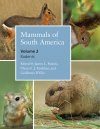Flora / Fauna Identification Key
By: James L Patton(Editor), Ulyses FJ Pardiñas(Editor), Guillermo D'Elía(Editor)
1336 pages, 549 b/w distribution maps, 1 b/w map, 1 table
![Mammals of South America, Volume 2 Mammals of South America, Volume 2]()
Click to have a closer look
About this book
Customer reviews
Biography
Related titles
About this book
The second installment in a planned three-volume series, Mammals of South America, Volume 2 provides the first substantive review of South American rodents published in over fifty years. Increases in the reach of field research and the variety of field survey methods, the introduction of bioinformatics, and the explosion of molecular-based genetic methodologies have all contributed to the revision of many phylogenetic relationships and to a doubling of the recognized diversity of South American rodents.
The largest and most diverse mammalian order on Earth - and an increasingly threatened one - Rodentia is also of great ecological importance, and Rodents is both a timely and exhaustive reference on these ubiquitous creatures. From spiny mice and guinea pigs to the oversized capybara, Mammals of South America, Volume 2 covers all native rodents of South America, the continental islands of Trinidad and Tobago, and the Caribbean Netherlands off the Venezuelan coast. It includes identification keys and descriptions of all genera and species; comments on distribution; maps of localities; discussions of subspecies; and summaries of natural, taxonomic, and nomenclatural history.
Mammals of South America, Volume 2 also contains a detailed list of cited literature and a separate gazetteer based on confirmed identifications from museum vouchers and the published literature.
Customer Reviews
Biography
James L. Patton is emeritus professor of integrative biology and curator of mammals at the Museum of Vertebrate Zoology, University of California, Berkeley. He is coeditor of Life Underground: The Biology of Subterranean Rodents, also published by the University of Chicago Press.
Ulyses F. J. Pardiñas is senior scientist at the Centro Nacional Patagonico, Puerto Madryn, Argentina.
Guillermo D'Elía is professor in the Instituto de Ciencias Ambientales y Evolutivas at the Universidad Austral de Chile, Valdivia.
Flora / Fauna Identification Key
By: James L Patton(Editor), Ulyses FJ Pardiñas(Editor), Guillermo D'Elía(Editor)
1336 pages, 549 b/w distribution maps, 1 b/w map, 1 table
"A must have for anyone with a serious interest in the mammals of South America!"
- Ian Paulsen, Birdbooker Report
"An amazing accomplishment. Rodents are by far the most diverse mammalian order on a global scale, and South America could justifiably be called the rodent continent. Charles Darwin himself remarked on the diversity of the South American rodent fauna, which is now known to include separate radiations of several major clades that arrived on the continent at different times. Those radiations are of exceptional interest to evolutionary biologists as examples of explosive diversification and niche-filling by lineages entering new adaptive zones. Because the South American mammal fauna as a whole is (literally) a textbook example of macroevolution, South American rodents are front-and-center as objects of active research interest. The editors have done a truly remarkable job of compiling these accounts, many of which provide the first-ever continent-wide treatments of notoriously difficult groups. No other collection of authors could possibly produce a comparable work, nor is it likely that any other editors could have successfully elicited such results over the many years this volume has been in gestation. It will have a large and enduring influence on Neotropical vertebrate zoology."
- Robert S. Voss, curator in the Department of Mammalogy, American Museum of Natural History
"A state-of-the-art compendium. This is not merely an updating of information that may have appeared in a previously published volume or assortment of separate volumes, but contains much new, never-before-published material and suggestions for future research. It and its predecessor not only constitute monumental contributions to the mammalogy of South America, but to mammalogy as a whole. The Mammals of South America series will be among the top few most important contributions to mammalogy of all time."
- Ronald H. Pine, adjunct research associate, Natural History Museum and Biodiversity Research Center, University of Kansas







































